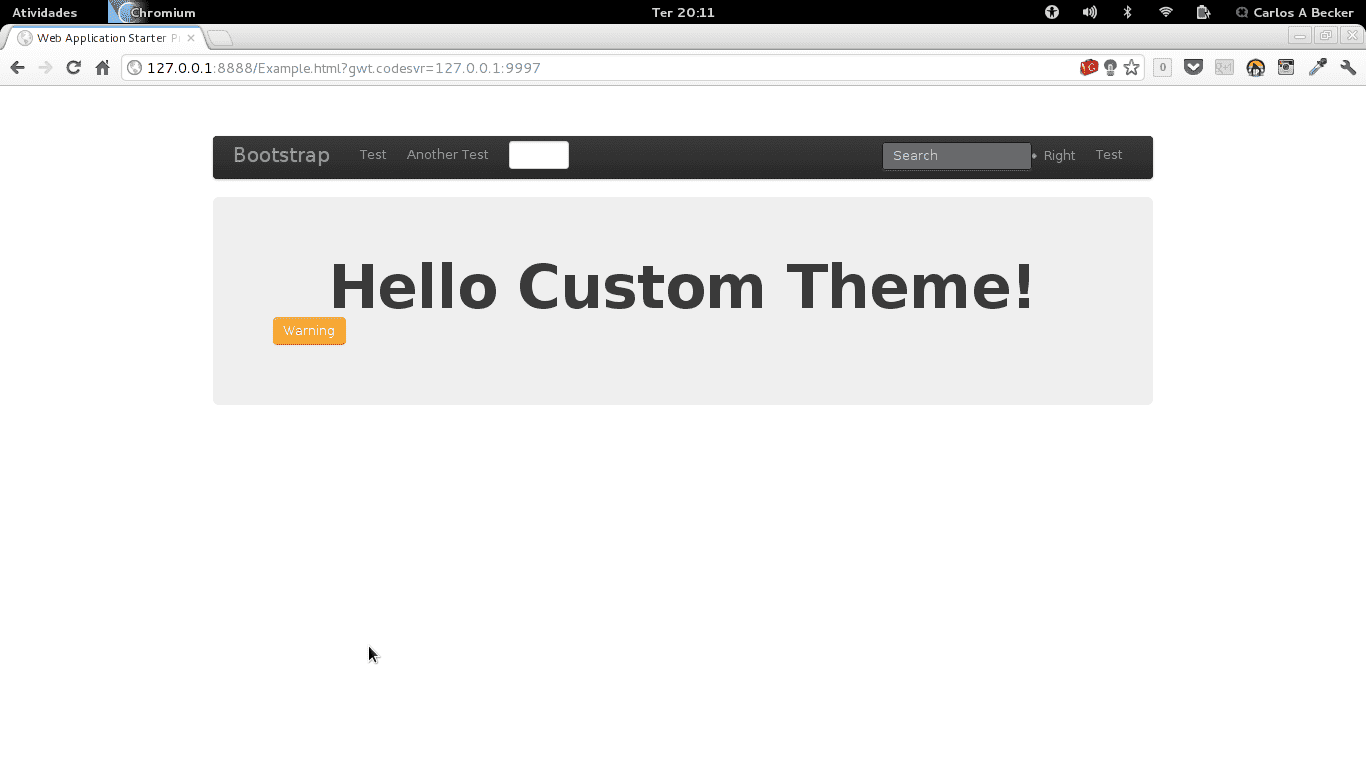Measuring production code coverage with JaCoCo
Microservices is the new fancy way of doing applications. Yet, most companies still have big …
First of all, if you haven’t done it yet, read Getting started with GWT-Bootstrap.
$ mvn archetype:generate \
-DarchetypeRepository=repo1.maven.org \
-DarchetypeGroupId=org.codehaus.mojo \
-DarchetypeArtifactId=gwt-maven-plugin \
-DarchetypeVersion=2.4.0
I created my project with the following properties:
Define value for property 'groupId': : com.github.caarlos0
Define value for property 'artifactId': : Example
Define value for property 'version': 1.0-SNAPSHOT: :
Define value for property 'package': com.github.caarlos0: :
Define value for property 'module': : Example
Now, lets add the GWT-Bootstrap dependency to the pom.xml file:
<repositories>
<repository>
<id>gwt-bootstrap</id>
<name>GWT-Bootstrap SNAPSHOTS</name>
<url>http://gwtbootstrap.github.com/maven/snapshots</url>
</repository>
</repositories>
<dependency>
<groupId>com.github.gwtbootstrap</groupId>
<artifactId>gwt-bootstrap</artifactId>
<version>2.0.4.0-SNAPSHOT</version>
</dependency>
And then, update your project with a $ mvn clean install.
In this point, we have to setup the *.gwt.xml file and our UIBinder XML file. You can follow getting started tutorial. to do that in the right way.
You can get a custom bootstrap.min.css file in several ways:
.less files and re-generating the filesFor this example, I’ll use this theme. Download the bootstrap.min.css from the site.
By default, the Maven GWT Archetype will generate a lot of junk, “by example”, for you. You can clean it up.
You can remove:
shared folder;server folder;EntryPoint class (Example, in our case);web.xml file;resources/client folder.At this point we will have a structure like this:
$ tree
|-- src
| |-- main
| | |-- java
| | | `-- com
| | | `-- github
| | | `-- caarlos0
| | | |-- client
| | | | |-- Example.java
| | | |-- server
| | | `-- shared
| | |-- resources
| | | `-- com
| | | `-- github
| | | `-- caarlos0
| | | `-- Example.gwt.xml
| | `-- webapp
| | |-- Example.css
| | |-- Example.html
| | `-- WEB-INF
| | `-- web.xml
| `-- test
`-- target
Now, lets create a UIBinder class to made our amazing test widget! Create a new UiBinder class/xml combo called ExampleUiBinder, with the following content:
<ui:UiBinder xmlns:ui='urn:ui:com.google.gwt.uibinder'
xmlns:g='urn:import:com.google.gwt.user.client.ui'
xmlns:b="urn:import:com.github.gwtbootstrap.client.ui">
<g:HTMLPanel>
<b:Container>
<b:Navbar>
<b:Brand>Bootstrap</b:Brand>
<b:Nav>
<b:NavLink>Test</b:NavLink>
<b:NavLink href="http://www.google.com">Another Test</b:NavLink>
</b:Nav>
<b:NavForm size="1"/>
<b:Nav alignment="RIGHT">
<b:NavLink>Test</b:NavLink>
</b:Nav>
<b:NavText alignment="RIGHT">Right</b:NavText>
<b:NavSearch size="2" placeholder="Search" alignment="RIGHT"/>
</b:Navbar>
<b:Hero>
<b:Heading size="1">Hello Custom Theme!</b:Heading>
<b:Button type="WARNING">Warning</b:Button>
</b:Hero>
</b:Container>
</g:HTMLPanel>
</ui:UiBinder>
public class ExampleUiBinder extends Composite {
interface ExampleUiBinderUiBinder
extends UiBinder<HTMLPanel, ExampleUiBinder> {
}
private static ExampleUiBinderUiBinder ourUiBinder =
GWT.create(ExampleUiBinderUiBinder.class);
public ExampleUiBinder() {
initWidget(ourUiBinder.createAndBindUi(this));
}
}
At this point, if everything is OK, we will get a window like this:

Right now, we will have to write our own Resources and Configuration classes. I’ll advise you that it’s a boring thing to do, but the result could be really awesome. So, let’s go.
We will have to create a resources folder under the same folder of our *.gwt.xml file. Just to you understand better, the folders client, shared, server and resources must be in the same hierarchical level, just like this:
$ tree
src/main/java/com/github/caarlos0/
|-- client
|-- resources
|-- server
`-- shared
Assuming that we will only change the CSS file, inside your resources file, create a css folder, and paste the bootstrap.min.css file downloaded before inside it. Yes, the file name must be bootstrap.min.css.
As said before, we also need a Resources and Configuration files. This files must be inside our resources folder too. The content is the following:
package com.github.caarlos0.resources;
import com.github.gwtbootstrap.client.ui.resources.Resources;
import com.google.gwt.resources.client.TextResource;
public interface ExampleResources extends Resources {
@Source("css/bootstrap.min.css")
TextResource bootstrapCss();
}
package com.github.caarlos0.resources;
import com.github.gwtbootstrap.client.ui.config.Configurator;
import com.github.gwtbootstrap.client.ui.resources.Resources;
import com.google.gwt.core.client.GWT;
public class ExampleConfigurator implements Configurator {
public Resources getResources() {
return GWT.create(ExampleResources.class);
}
public boolean hasResponsiveDesign() {
return false;
}
}
At this point, the structure should be something like this:
$ tree
src/main/java/com/github/caarlos0/
|-- client
| |-- Example.java
| |-- ExampleUiBinder.java
| |-- ExampleUiBinder.ui.xml
|-- resources
| |-- css
| | `-- bootstrap.min.css
| |-- ExampleConfigurator.java
| `-- ExampleResources.java
|-- server
`-- shared
Now, we have to do a little hack in our *.gwt.xml. We will need to replace com.github.gwtbootstrap.client.ui.config.Configurator with our Configurator, and setup the resources dir. So, in the end, we will have something like this:
<?xml version="1.0" encoding="UTF-8"?>
<module rename-to='Example'>
<inherits name='com.google.gwt.user.User'/>
<inherits name='com.google.gwt.junit.JUnit'/>
<inherits name='com.google.gwt.user.theme.standard.Standard'/>
<inherits name="com.github.gwtbootstrap.Bootstrap"/>
<entry-point class='com.github.caarlos0.client.Example'/>
<source path='client'/>
<source path='shared'/>
<!--pay attention in this part-->
<source path='resources'/>
<replace-with class="com.github.caarlos0.resources.ExampleConfigurator">
<when-type-is class="com.github.gwtbootstrap.client.ui.config.Configurator"/>
</replace-with>
<public path="resources">
<exclude name="** /*.java"/>
<exclude name="** /*.class"/>
</public>
</module>
That’s it :)

Sometimes GWT caches everything, and seems like it doesn’t work. In this cases, do the following:
mvn clean;webapp/Example folder (in our case, Example is the Module name);If it still dont working, do this:
<source path='resources'/> tag in your *.gwt.xml;For me, this process always works.